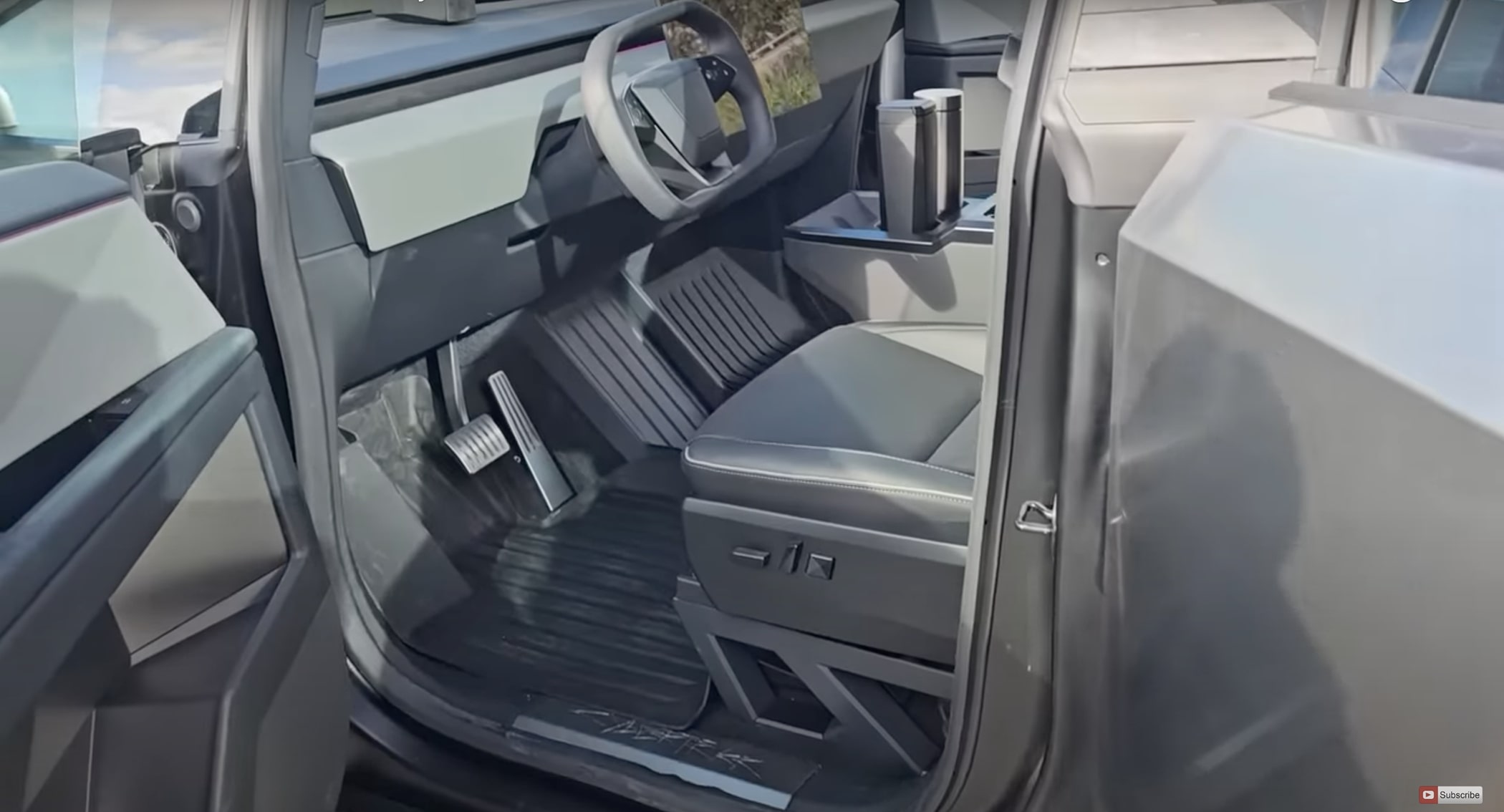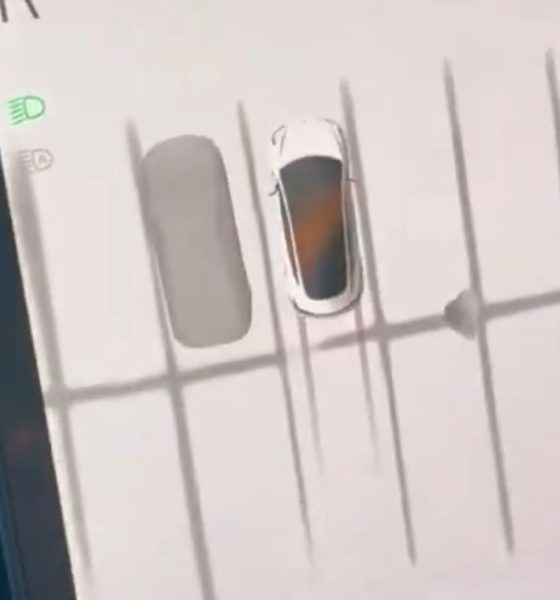Release notes for Tesla’s holiday software update were shared earlier this month, including the addition of the High Fidelity Park Assist feature. Some have since shared footage of the feature in action, showing how it works in parking lots and garages as users evaluate its usefulness when trying to park.
Tesla’s holiday update release notes were shared on X earlier this month, where the company first mentioned the new High Fidelity Park Assist mode. Tesla owner Ryan Hoffman, along with others, have shared videos of the feature on X, including one taken in a Supercharger lot on Saturday.
As can be seen in the video, the activated High Fidelity Park Assist mode shows a similar view to the highly requested Birds Eye 360-degree visualization. Hoffman says he drives a 2023 Model 3 RWD with HW3 and the Ryzen chip, meaning the car doesn’t have Ultrasonic Sensors (USS) and utilizes just Tesla Vision.
The video is taken at a Supercharger station, where Hoffman backs into a charging spot. Behind the visualization of the car, you can see an orange and yellow zone, signifying the vehicle’s close proximity to the charging pile. The top-down visualization shows that it recognizes the charging stalls as well as the parking lines on the ground, making it easy to back into the spot without the car ending up crooked.
He also shared a short video of what it looks like to back into the spot, including the actual rear camera’s video footage and the High Fidelity Park Assist view, and calling the feature a “game changer” for parking.
Here’s a short video of what it looked like to reverse into the spot. The lines for each parking spot are very handy… it’s a game changer for parking. pic.twitter.com/47BDBbXw7z
— Ryan Hoffman (@tekmaven) December 16, 2023
Others have shared similar footage of High Fidelity Park Assist, as many have wondered how exactly the feature is activated when being used in a parking lot. According to X user EVBaymax, the feature appears to engage when there is a clearly defined object in front of or around the car, and when users shift into reverse in a parking lot. Still, the current version seems to lack the ability to engage when driving forward, although it probably should have this ability.
In his videos of the feature, you can see the visualization switch on from the regular Autopilot view when reversing in the parking lot, and he also says that speeding up to around 15-20 mph makes the visualization disappear again. He goes on to call the feature “surprisingly accurate” and “definitely helpful,” and he also includes footage using it in a darker, in-garage environment.
Here’s what the switch from Autopilot visualizations to High-Fidelity Park Assist looks like in a parking lot pic.twitter.com/xtx8BylI0W
— kEV (@EVBaymax) December 16, 2023
You can see in the above videos that the feature still requires some prodding to work as desired, though once it’s engaged, it looks to be pretty useful. It does, however, appear to fill the need that many have requested with Birds Eye, 360-degree views, as the top-down visualizer makes it especially easy to see where the vehicle is in relation to other cars, parking lines, and more when parking.
Tesla CEO Elon Musk recently said that the company’s cars will eventually offer a convenient “Tap to Park” feature, in which the vehicle will identify open parking spots and let drivers select on-screen which to use, then letting the driver get out and allow the car to park itself in the selected space. Still, many are awaiting updates like Tesla’s Actually Smart Summon and the automaker only reintroduced its Vision-based Park Assist earlier this year.
Tesla Model 3 Highland owner’s manual confirms Auto Shift out of Park feature
What are your thoughts? Let me know at zach@teslarati.com, find me on X at @zacharyvisconti, or send your tips to us at tips@teslarati.com.

News
Tesla adjusts crucial feature as winter weather arrives

Tesla has adjusted the functionality of a crucial climate feature as Winter weather has started to arrive throughout some parts of the United States. The new feature was highly requested by owners.
Tesla has a Cabin Overheat Protection feature that helps keep the temperature regulated if it reaches a certain threshold. Inversely, it can be used in cold weather as well, which will automatically warm the cabin if it sinks to a temperature that is too low for the owner’s comfort.
This is a great way to keep the cabin either warmed up just enough or cooled down just enough so that it never gets too hot or too cold. Extreme temperatures could damage certain parts of the vehicle or damage personal belongings that are kept inside the car.
Overheat protection is a great thing to have in hot climates like Arizona or Texas, especially with the Premium trims of the Model 3 and Model Y, which feature a glass roof.
Many owners appreciate the feature, but they argue that using it at home will utilize too much energy, especially during extreme temperatures. For a while, many Tesla fans have requested an option to disable this feature when the car is parked at home, which the company recently added, according to Not a Tesla App.
The feature is part of Software Version 2025.44.3, and the release notes state:
“You can now choose Exclude Home when Cabin Overheat Protection or No A/C is enabled.”
Tesla has been great at listening to what owners want with new features, and this is one that will reserve some charge and prevent unnecessary utilization of available power, especially as the car is parked at home. If owners want to condition the cabin or get the car ready for operation with a comfortable interior, they can utilize the Tesla app to adjust the climate.
Elon Musk
Tesla CEO Elon Musk sends rivals dire warning about Full Self-Driving

Tesla CEO Elon Musk revealed today on the social media platform X that legacy automakers, such as Ford, General Motors, and Stellantis, do not want to license the company’s Full Self-Driving suite, at least not without a long list of their own terms.
“I’ve tried to warn them and even offered to license Tesla FSD, but they don’t want it! Crazy,” Musk said on X. “When legacy auto does occasionally reach out, they tepidly discuss implementing FSD for a tiny program in 5 years with unworkable requirements for Tesla, so pointless.”
I’ve tried to warn them and even offered to license Tesla FSD, but they don’t want it! Crazy …
When legacy auto does occasionally reach out, they tepidly discuss implementing FSD for a tiny program in 5 years with unworkable requirements for Tesla, so pointless. 🤷♂️
🦕 🦕
— Elon Musk (@elonmusk) November 24, 2025
Musk made the remark in response to a note we wrote about earlier today from Melius Research, in which analyst Rob Wertheimer said, “Our point is not that Tesla is at risk, it’s that everybody else is,” in terms of autonomy and self-driving development.
Wertheimer believes there are hundreds of billions of dollars in value headed toward Tesla’s way because of its prowess with FSD.
A few years ago, Musk first remarked that Tesla was in early talks with one legacy automaker regarding licensing Full Self-Driving for its vehicles. Tesla never confirmed which company it was, but given Musk’s ongoing talks with Ford CEO Jim Farley at the time, it seemed the Detroit-based automaker was the likely suspect.
Tesla’s Elon Musk reiterates FSD licensing offer for other automakers
Ford has been perhaps the most aggressive legacy automaker in terms of its EV efforts, but it recently scaled back its electric offensive due to profitability issues and weak demand. It simply was not making enough vehicles, nor selling the volume needed to turn a profit.
Musk truly believes that many of the companies that turn their backs on FSD now will suffer in the future, especially considering the increased chance it could be a parallel to what has happened with EV efforts for many of these companies.
Unfortunately, they got started too late and are now playing catch-up with Tesla, XPeng, BYD, and the other dominating forces in EVs across the globe.
News
Tesla backtracks on strange Nav feature after numerous complaints

Tesla is backtracking on a strange adjustment it made to its in-car Navigation feature after numerous complaints from owners convinced the company to make a change.
Tesla’s in-car Navigation is catered to its vehicles, as it routes Supercharging stops and preps your vehicle for charging with preconditioning. It is also very intuitive, and features other things like weather radar and a detailed map outlining points of interest.
However, a recent change to the Navigation by Tesla did not go unnoticed, and owners were really upset about it.
For trips that required multiple Supercharger stops, Tesla decided to implement a naming change, which did not show the city or state of each charging stop. Instead, it just showed the business where the Supercharger was located, giving many owners an unwelcome surprise.
However, Tesla’s Director of Supercharging, Max de Zegher, admitted the update was a “big mistake on our end,” and made a change that rolled out within 24 hours:
The naming change should have happened at once, instead of in 2 sequential steps. That was a big miss on our end. We do listen to the community and we do course-correct fast. The accelerated fix rolled out last night. The Tesla App is updated and most in-car touchscreens should…
— Max (@MdeZegher) November 20, 2025
The lack of a name for the city where a Supercharging stop would be made caused some confusion for owners in the short term. Some drivers argued that it was more difficult to make stops at some familiar locations that were special to them. Others were not too keen on not knowing where they were going to be along their trip.
Tesla was quick to scramble to resolve this issue, and it did a great job of rolling it out in an expedited manner, as de Zegher said that most in-car touch screens would notice the fix within one day of the change being rolled out.
Additionally, there will be even more improvements in December, as Tesla plans to show the common name/amenity below the site name as well, which will give people a better idea of what to expect when they arrive at a Supercharger.










